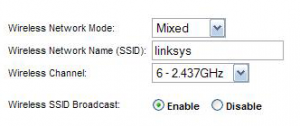Wifi Network - Protect Yourself
Wireless is one of the biggest areas of attack, but at the same time there are some very simple steps you can take to practically protect yourself against almost all wireless attacks. Anyone that isn’t entirely computer illiterate will have the ability to understand these concepts to ensure their own wireless network is safe and sound from any would-be predators.
Your Home Network
Encryption
WEP
Taken from Wikpedia is the best description I have found:
Wired Equivalent Privacy (WEP) is a deprecated security algorithm for IEEE 802.11 wireless networks. Wireless transmission is susceptible to eavesdropping and, so, WEP was introduced as part of the original 802.11 protocol in 1997.[1] It was intended to provide confidentiality comparable to that of a traditional wired network.
I actually underlined “intended” because the fact of the matter is that it didn’t really accomplish it’s goal. WEP was easily broken and is about as inviting as not having any sort of wireless encryption. While I thought it important enough to mention here, because of the sad fact that it is still so widely used, I’m not in any way suggesting you should use it at all. It’s out dated, broken, and worthless to put it nicely.
WPA
For comparison, here is what Wikipedia has to say about WPA:
Wi-Fi Protected Access (WPA and WPA2) is a certification program developed by the Wi-Fi Alliance to indicate compliance with the security protocol created by the Wi-Fi Alliance to secure wireless computer networks. The Alliance defined the protocol in response to several serious weaknesses researchers had found in the previous system, WEP.
Assuming your wireless router and laptop support it, always use WPA2. It is currently the best available.
Disable SSID Broadcasting
The wireless SSID is simply the name you give your wireless access point/router to be able to connect to it. When it has not been disabled(the default is not to be disabled), and you use your wireless device to find a wireless access point to connect to, it will show the SSID name. What this means is that any predator within distance of your wireless router will be able to see that it exists and also try connecting. If you had no password/encryption, they’d be able to get right on in.
Every wireless access point/router/device is different, so you’ll have to figure out where the option is to disable SSID broadcasting based on what you have. You’ll want to turn it off though, because doing otherwise is like shouting, “Hey, I’m over here! Come see if I’m insecure or not!”
Public Networks
Virtual Private Network (VPN)
We’ve already talked about how you can use a VPN to browse/torrent/usenet anonymously (as well as access region blocked content). Well, you can also use a VPN to secure your connection when connected to public wifi. It’s the exact same process.
HTTPS-Everywhere
HTTPS-Everywhere is a plugin that can be downloaded for Firefox or Chrome. It forces you to use the HTTPS version of thousands of popular sites, even if you type in http:// , so that you’re always secured and never accidently sending passwords when logging in. With that being said, I suggest you only log in to sites when you absolutely must when using a public network. It’s just a bad habit in general, unless you’re over a secured VPN.

